Zoom powers connections for millions of people every day. Businesses use it to hold team meetings, schools rely on it for virtual classes, and families turn to it for catching up across distances.
If you want to understand Zoom’s users better and see how you can leverage it for your own needs—like boosting productivity in remote work or hosting engaging webinars—this article dives deep.
We explore user numbers, growth trends, revenue, and more. Plus, we pull in fresh insights from online discussions where people ask about the latest stats, such as how Zoom stacks up against competitors in 2025.
Zoom offers features like screen sharing, breakout rooms, and AI-powered summaries that make collaboration easy and efficient. You can start with a free account to test it out and scale up as your needs grow.
Table of Contents
ToggleZoom Statistics 2026: Top Picks
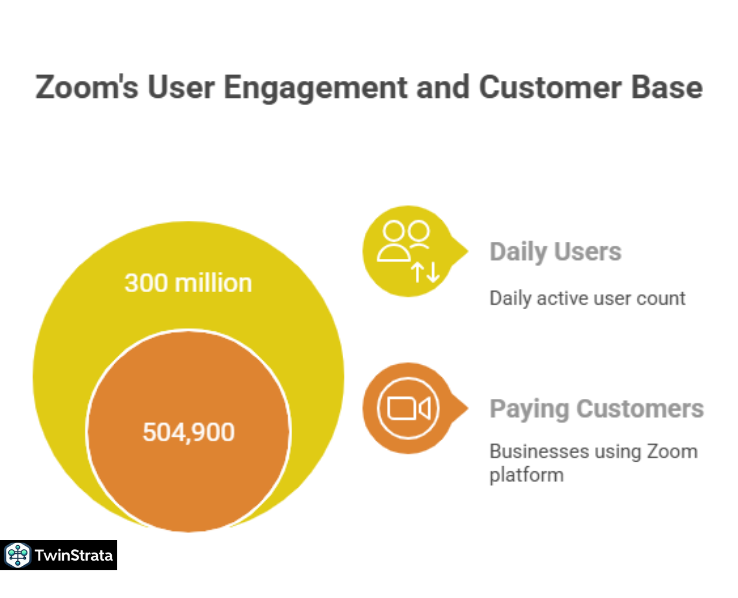
Zoom attracts 300 million daily active users who join meetings worldwide. This massive user base means you get a reliable platform with minimal downtime, perfect if you run a small business or manage remote teams.
Zoom earns $4.66 billion in annual revenue for 2024, showing its strong financial health and ability to invest in new tools like Zoom Phone for calls. Users log over 3.3 trillion annual meeting minutes on Zoom, which highlights how much people depend on it for daily interactions.
Zoom commands 55.91% of the video conferencing market share, making it the go-to choice over rivals like Microsoft Teams. Businesses count 504,900 customers on Zoom, including 70% of Fortune 100 companies that use it for secure communications.
A whopping 89% of users fire up Zoom for business meetings, but 63% also chat with friends and family, so you can mix professional and personal use seamlessly.
How Many Zoom Users Are There?
Zoom draws in over 300 million daily active users right now. These users include everyone from free account holders hosting casual video calls to paid subscribers running large-scale webinars.
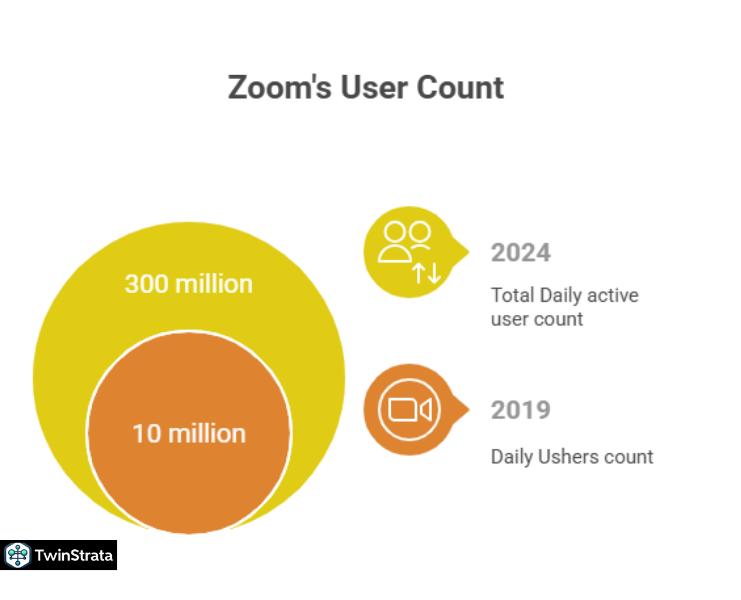
You benefit from this huge community because it ensures constant updates and features tailored to real-world needs, like enhanced security to protect your conversations.
Back in December 2019, Zoom only had 10 million daily users, but the pandemic sparked a 2900% surge by April 2020.
Today, Zoom serves 470,000 paying business customers who rely on it for everything from client pitches to internal brainstorming. If you own a business, you can tap into Zoom’s user-friendly interface to connect with clients globally without travel costs.
Here is a table showing the growth in daily Zoom users over the years:
| Year | Number of Daily Active Users |
| December 31, 2019 | 10 million |
| March 31, 2020 | 200 million |
| April 21, 2020 | 300 million |
| January 2024 | 300 million+ |
| 2025 (estimated) | 300 million+ |
Source: Business Insider.
This growth lets you join a platform that evolves quickly. For instance, recent online talks on forums highlight users asking about Zoom’s edge over Teams—Zoom’s 300 million daily users slightly trail Teams’ 320 million, but Zoom wins in ease for education and small groups. You can use this to your advantage by choosing Zoom for quick setup in virtual interviews or team huddles
Zoom Revenue 2026
Zoom reports $1.175 billion in revenue for the first quarter of fiscal year 2025. This strong start builds on 2024’s full-year haul of $4.66 billion. Businesses drive most of this income through subscriptions that unlock unlimited meeting times and advanced analytics.
If you subscribe, you gain tools like attendance reports to track engagement in your sessions. Zoom’s revenue climb shows its stability, so you invest in a service that won’t disappear overnight.
Check out this table for Zoom’s revenue over recent fiscal years:
| Fiscal Year | Revenue ($ million) |
| Q1 2025 | 1,175 |
| 2024 | 4,665 |
| 2023 | 4,393 |
| 2022 | 4,100 |
| 2021 | 2,651 |
| 2020 | 623 |
| 2019 | 331 |
Source: Business of Apps
Zoom pulls in cash from features like Zoom Phone, which now boasts 7 million paid seats for voice calls integrated with video. You can use this to streamline your communications—imagine handling calls and meetings in one app, saving time and reducing app-switching frustration.
Zoom Market Share
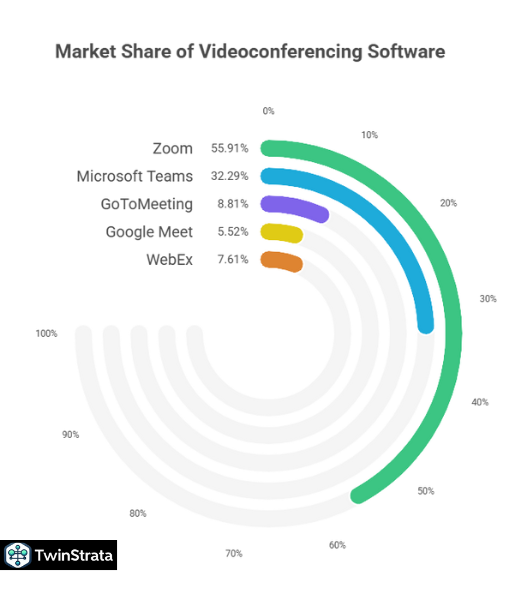
Zoom grabs 55.91% of the global videoconferencing market. This dominance means you access a platform with widespread adoption, making it easy to invite anyone without compatibility issues.
Microsoft Teams follows at 32.29%, but Zoom leads in user-friendliness for non-tech-savvy folks. If you host webinars, Zoom’s market position ensures high attendance rates since most people already know how to use it.
Here’s a breakdown of market shares for top videoconferencing tools as of 2023, with trends holding into 2025:
| Software | Market Share (%) |
| Zoom | 55.91 |
| Microsoft Teams | 32.29 |
| GoToMeeting | 8.81 |
| Google Meet | 5.52 |
| WebEx | 7.61 |
| RingCentral | 5.31 |
| FaceTime | 2.16 |
| Skype | 1.41 |
| Facebook Messenger | 0.75 |
| BlueJeans | 0.31 |
Source: Statista
Zoom’s share grew 22.3% from 2020 levels, reflecting its appeal in sectors like telemedicine where quick, clear video matters. You can benefit by using Zoom for client consultations, knowing it’s trusted by over half the market.
Zoom Usage Statistics

Businesses worldwide turn to Zoom for critical communications. Over 504,900 companies use it, including 70% of Fortune 100 firms that depend on its encryption for secure talks.
You gain from this by adopting a tool vetted by big players—think robust features like virtual backgrounds to professionalize your setup. More than 50% of Fortune 500 companies integrate Zoom, and 85% of Forbes Cloud 100 firms do too. Banks especially love it: 8 in 10 largest US banks connect digitally via Zoom.
89% of people use Zoom for work meetings, fostering connections that make remote teams feel closer. During the pandemic, 89% of employees reported better colleague bonds through virtual sessions. Organizations interviewed 86% of candidates via video in 2020, a trend that sticks in 2025 for efficient hiring. If you recruit, Zoom cuts travel expenses and speeds up decisions.
Zoom counts 509,800 customers with over 10 employees as of 2022, up from 467,100 in 2021. These larger clients generate 64% of revenue, showing Zoom scales well for growing teams. You can start small and expand without switching apps.
See the table for customers with more than 10 employees:
| Year | Customers with >10 Employees |
| 2022 | 509,800 |
| 2021 | 467,100 |
| 2020 | 81,900 |
| 2019 | 25,800 |
| 2018 | 10,900 |
Zoom also has 3,731 business customers contributing over $100,000 annually in recurring revenue, up from 2,278 in 2021. This 131% growth since 2020 means enterprises invest heavily, funding innovations like AI companions that transcribe meetings for you. Average large client revenue hits $108,529 yearly. If your business grows, you tap into enterprise-grade support.
Recent online queries reveal users asking about Zoom’s user demographics. The 25-34 age group makes up 29.71% of users, ideal if you target young professionals with training sessions. The US drives 37% of Zoom’s traffic, so American users enjoy faster servers and localized features.
Zoom Meeting Minute Statistics
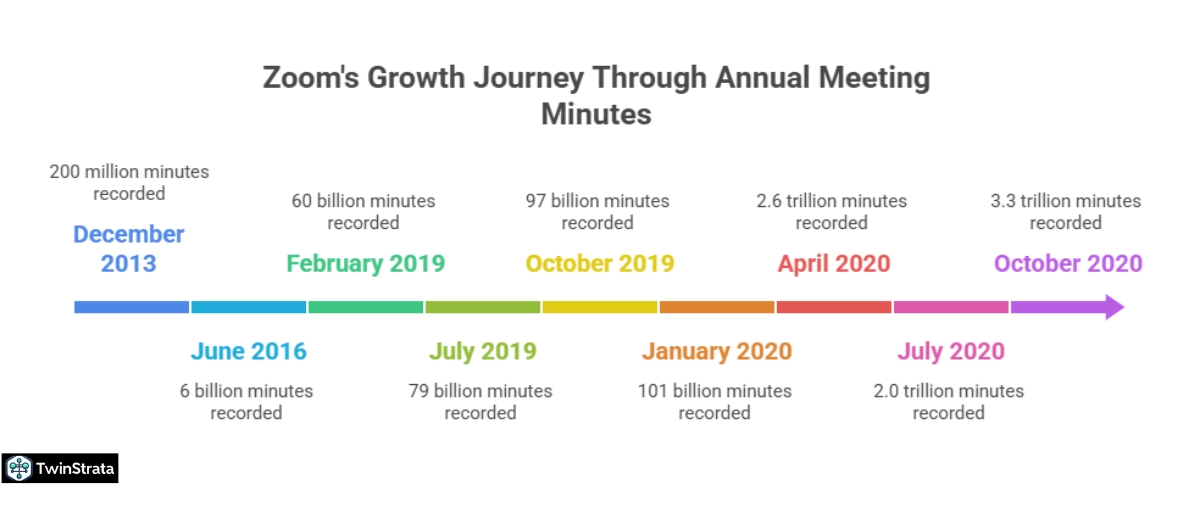
Zoom hosts 3.3 trillion annual meeting minutes. This massive volume equals countless productive hours—multiply the last month’s minutes by 12 for the estimate. You benefit from a platform handling such scale without lags, ensuring smooth calls even in peak times. Minutes jumped 65% from the prior year, driven by hybrid work.
Track the growth in this table:
| Quarter, Fiscal Year | Annual Meeting Minutes |
| October 2020 | 3.3 trillion |
| July 2020 | 2.0 trillion |
| April 2020 | 2.6 trillion |
| January 2020 | 101 billion |
| October 2019 | 97 billion |
| July 2019 | 79 billion |
| February 2019 | 60 billion |
| June 2016 | 6 billion |
| December 2013 | 200 million |
With 350 million daily participants at pandemic peak, Zoom proves its reliability for your daily stand-ups or global conferences.
Zoom Webinar Minute Statistics
Zoom records over 45 billion annual webinar minutes. This 7.14% rise from 42 billion last year shows webinars thrive on Zoom. You can host events with up to 100,000 viewers, perfect for marketing or education. Minutes spiked 14 times in April 2020 as everything went online.
Here’s the webinar growth table:
| Month, Year | Annual Webinar Minutes |
| October 2020 | 45 billion+ |
| July 2020 | 42 billion |
| April 2020 | 42 billion |
| January 2020 | 3 billion |
| October 2019 | 3 billion |
| July 2019 | 2 billion |
Fun fact: Only 40% of attendees focus fully, so keep webinars to 30 minutes for max engagement. You use polls and Q&A to boost interaction.
Zoom Downloads
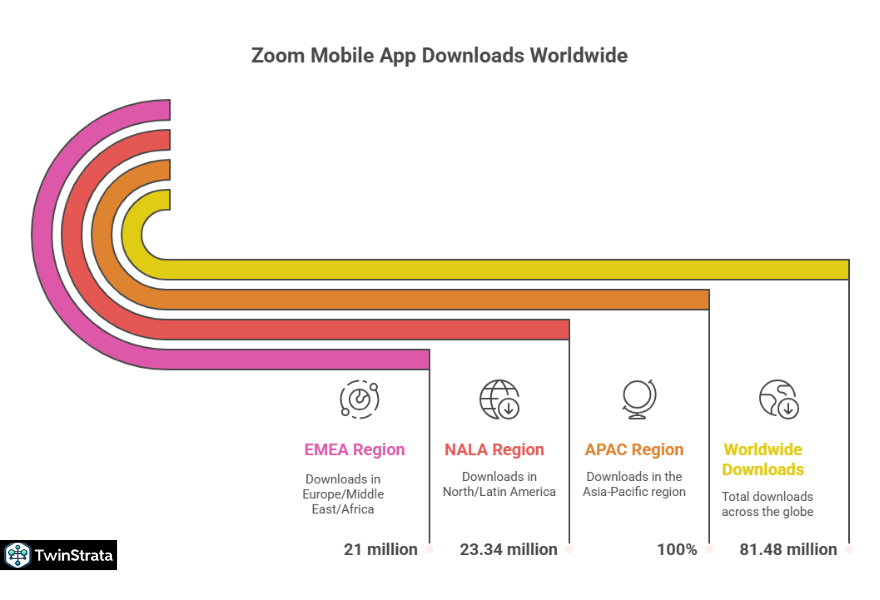
Zoom tops download charts in the US with 37 million in 2022. This beats Microsoft Teams’ 25 million, making Zoom the app people grab first for video needs. If you promote events, high downloads mean easy access for invitees. Okta reports 48% of Microsoft 365 users add Zoom, up from 45% in 2021—proof of its versatility.
In the first half of 2023, APAC saw 37.14 million downloads, EMEA 21 million, and NALA 23.34 million. Pandemic highs hit 297.42 million in APAC alone in 2020.
Regional downloads table:
| Year (or Period) | APAC (million) | EMEA (million) | NALA (million) |
| 2023 (first half) | 37.14 | 21 | 23.34 |
| 2022 | 90.58 | 45.5 | 51.15 |
| 2021 | 161.65 | 79.67 | 86.15 |
| 2020 | 297.42 | 182.42 | 260.42 |
Worldwide, 81.48 million downloads occurred in 2023’s first half, down from 2020’s 740.26 million peak. You download it free on mobile or desktop to start benefiting immediately.
Annual worldwide downloads table:
| Year (or Period) | Worldwide Downloads (million) |
| 2023 (first half) | 81.48 |
| 2022 | 187.23 |
| 2021 | 324.47 |
| 2020 | 740.26 |
Zoom Net Income
Zoom posts $103.71 million net income for fiscal 2023, down from prior highs due to post-pandemic shifts. Offices reopening cut demand, but Zoom adapts with new features. Shares dropped 42% last year, yet core strength remains. You trust a profitable company for long-term support.
Net income table:
| Fiscal Year | Net Income ($ million) |
| 2023 | 103.71 |
| 2022 | 1,375.64 |
| 2021 | 672.32 |
| 2020 | 25.31 |
| 2019 | 7.58 |
In 2024, net income rebounds to $1.01 billion, fueling expansions like AI tools for business.
How Many Employees Does Zoom Have?
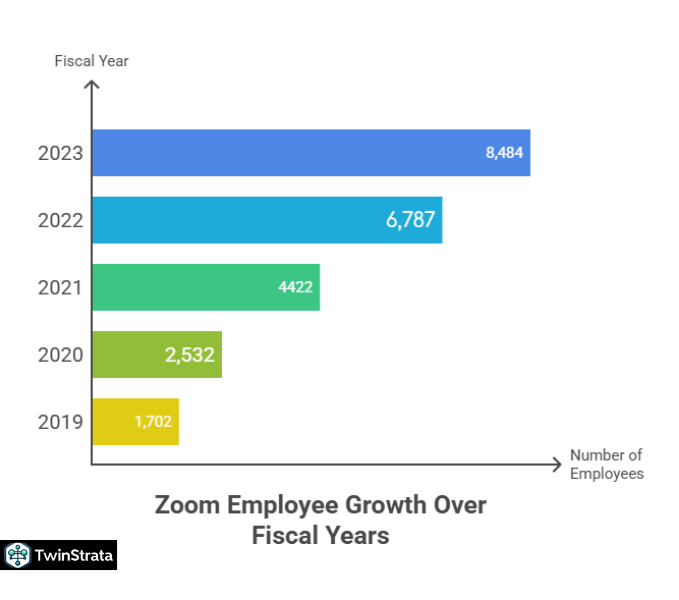
Zoom employs 8,484 people total. This 25% increase from 2022 supports global operations. Peak growth hit 74.64% in 2021 amid demand surge. Expect slight drops in 2025 as Zoom trims costs, but the core team stays innovative.
Employees table:
| Fiscal Year | Number of Employees |
| 2023 | 8,484 |
| 2022 | 6,787 |
| 2021 | 4,422 |
| 2020 | 2,532 |
| 2019 | 1,702 |
53.4% of employees identify as White, 22.4% Asian, with 4,588 in the US and 3,896 internationally. Diverse teams build inclusive features, like multilingual captions for your global meetings.
Zoom Business Customers Update
Zoom serves 192,600 enterprise customers in 2024, down slightly from 220,400 in 2023 but still robust. You join a network of 3,731 high-value clients paying over $100K yearly. This focus on enterprises means premium security for your data.
Business customers table:
| Year | Business Customers |
| 2024 | 192,600 |
| 2023 | 220,400 |
| 2022 | 213,000 |
| 2021 | 191,000 |
| 2020 | 470,100 |
| 2019 | 82,400 |
FAQs About Zoom Statistics
1. How many daily active users does Zoom have in 2025?
Zoom has over 300 million daily active users in 2025, which includes both free and paid accounts participating in meetings worldwide.
2. What is Zoom's market share compared to Microsoft Teams?
Zoom holds 55.91% of the videoconferencing market, while Microsoft Teams has 32.29%, making Zoom the preferred choice for many in education and small businesses.
3. How can businesses benefit from Zoom's features?
Businesses benefit from Zoom by using its screen sharing, breakout rooms, and AI transcriptions to enhance team collaboration, reduce travel costs, and conduct secure client meetings efficiently.
4. What are the latest trends in Zoom downloads?
In the first half of 2023, Zoom saw 81.48 million worldwide downloads, with the Asia-Pacific region leading at 37.14 million, reflecting ongoing demand for mobile access in remote work.
5. How has Zoom's revenue grown recently?
Zoom’s revenue reached $4.66 billion in 2024, up 3% from the previous year, driven by enterprise subscriptions and expansions like Zoom Phone with 7 million paid seats.
Also Read:
- Video Marketing Statistics
- Digital Marketing Statistics
- Internet Usage Statistics
- AI Market Size Statistics
- Elearning Statistics
Conclusion:
Zoom cements its lead in videoconferencing, serving millions daily. Its 300 million active users and billions in revenue underline reliability. You harness this for better connections—whether growing your business or staying close to loved ones. As hybrid work persists, Zoom evolves, adding AI and phone integrations to keep you ahead.
